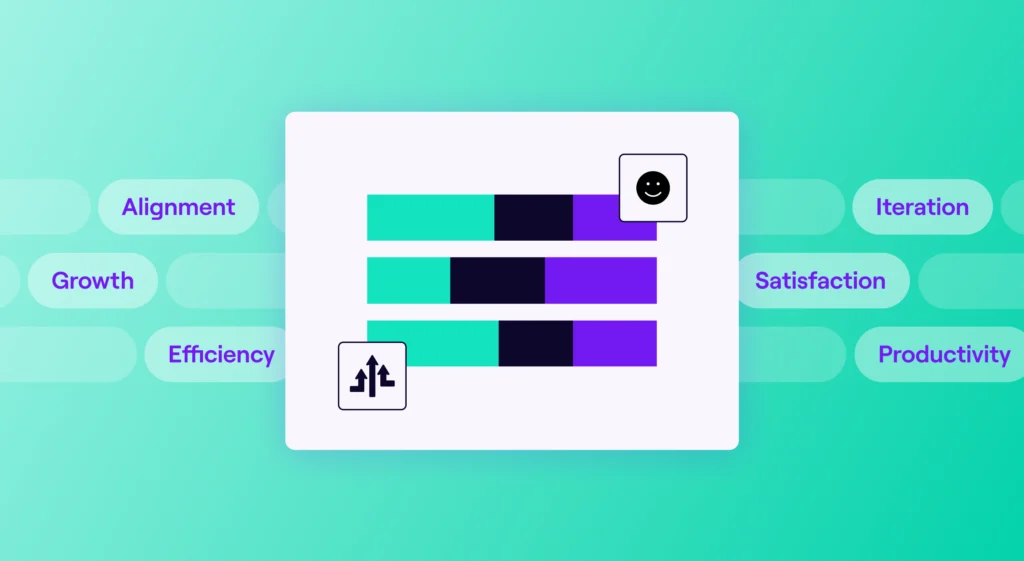Performance management tools such as Salesforce, Marketo, and Hubspot have long supported sales, legal, marketing, and finance teams. These tools provide visibility into day-to-day operations and help teams keep tabs on essential areas like budget, milestones, or ROI.
Despite software development’s growing importance and prevalence in today’s business landscape, many engineering departments are operating in a black box, with little visibility into what people are working on, where projects stand, and more.
At Jellyfish, we know that this lack of visibility compounds many of the daily challenges that keep engineering managers on the frontlines of software development up at night.
That’s why we designed Jellyfish to deliver value across the entire engineering hierarchy — including to engineering managers. If companies want to run successful, sustainable software engineering departments, they must empower their engineering managers with data — just like they do for sales, marketing, and finance.
Read on to explore how different features within the Jellyfish platform can support engineering managers in their day to day.
Communicate Delivery Management Confidently with Scenario Planner
Often, EMs are forced to rely on gut feelings or guesses to inform critical delivery decisions, such as whether they should add an engineer to an initiative, cut project scope, or consider other tradeoffs to accelerate a project with increasing priority.
With Jellyfish’s Scenario Planner, engineering managers can understand the entire story of work for a project and how that story changes if different variables are tweaked. In other words, you can use Scenario Planner to analyze different possible tradeoffs and ensure you’re working efficiently with your team so that your highest-priority initiatives have clear delivery goals and deadlines (and that you meet them!).
Here’s how you can adjust the three core variables within Scenario Planner to optimize delivery management:
- Scope: This tells you the total remaining scope for a deliverable. If you’re close to a target launch date and still have a significant remaining scope, you may want to look at what you can cut for a fast follow-up after launch.
- Developers: See who is working on development of a deliverable. Dig in to see what competing priorities the team has — or if anyone can devote more time to your project.
- Average Attention: See how much average attention the people working on a project can devote to it. If this work is a higher priority than some of the competing priorities, you can communicate that to the team and stakeholders and ensure the development stays more focused.
Jellyfish Tip: Share a screenshot of Scenario Planner with leadership and your team before implementing significant changes to ensure everyone is on the same page.
Banish Bottlenecks with Life Cycle Explorer
Bottlenecks in the development lifecycle may stem from resourcing issues, technical debt, or general inefficiencies. Identifying the true root cause of bottlenecks requires a complete and transparent view of deliverables and processes.
That’s where Jellyfish’s Life Cycle Explorer comes in. With Life Cycle Explorer, you can analyze your operational processes and trends at the issue level. Dive into a granular view of how your engineering teams progress through the lifecycle to understand better where things are getting stuck in the mud and where you can improve processes for your team.
In Life Cycle Explorer, you can look at the following features to identify and mitigate bottlenecks:
- Life Cycle by Phase: Track where your team spends the most time and see if that aligns with your expectations. For example, if refinement time is super high, do you need to define work better?
- Trend Over Time: See how work in different phases is trending. Inspect “Outliers” to uncover where specific issues might have blown your team off course.
Monitor Team Health and Fend Off Burnout with DevEx
Your software engineering team is likely made up of different personalities, work styles, and backgrounds. Refining your leadership skills can go a long way in managing your team, but having quantitative and qualitative findings at your fingertips can also go a long way in building trust and facilitating more productive conversations with your team.
In general, an EMP like Jellyfish can provide a wealth of quantitative insights into your team’s work, milestones to celebrate, areas for growth, and more. However, hard data often only tells half the story.
Engineering managers can supplement the quantitative with qualitative insights from Jellyfish DevEx. With Jellyfish DevEx, engineering managers can deploy surveys to understand the developer experience better.
Engineering managers can then analyze survey results by looking at variables such as:
- Participant Segments: This lets you look at survey results based on different attributes, such as team, technical focus, location, or tenure.
- Topics: Look at different developer experience topics for all teams and identify topic areas with positive or negative skewing sentiments.
- Actionable Suggestions: In-app suggestions explain the meaning behind scores and recommend possible actions to improve perception and drive outcomes.
- Qualitative Comments: Dig deeper into pain points and give developers a voice with the free comments option.
Ready to Become a Data-Backed Engineering Department?
Jellyfish offers tools and additional resources that support EMs throughout their careers, including a robust help center, direct guidance from Jellyfish experts, and a library of on-demand webinars to demo our most popular features.
Jellyfish has been career-changing. It’s nice to use data to make decisions instead of feelings.
David Randall, Director of Engineering at CHG Healthcare.
Want to dig into the nitty gritty? Check out our on-demand webinar, “Jellyfish for Engineering Managers,” to explore Jellyfish’s complete offerings for engineering managers like yourself.







